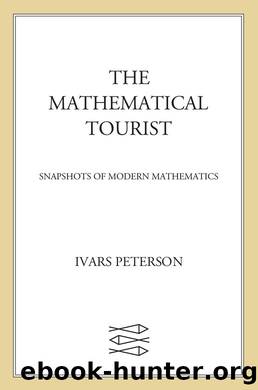The Mathematical Tourist by Ivars Peterson

Author:Ivars Peterson
Language: eng
Format: epub
Publisher: Henry Holt and Co.
Published: 2011-08-08T00:00:00+00:00
THE LANGUAGE OF NATURE
A close look shows that many natural forms, despite their irregular or tangled appearance, share a remarkable feature on which a new geometry can be hung. Clouds, mountains, and trees wear their irregularity in an unexpectedly orderly fashion. Nature is full of shapes that repeat themselves on different scales within the same object.
A fragment of rock looks like the mountain from which it was fractured. Clouds keep their distinctive appearance whether viewed from the ground or from an airplane window. A treeâs twigs often have the same branching pattern seen at the treeâs trunk. Elms, for instance, have two branches coming out of most forks. In a large tree, this repeated pattern, on ever smaller scales, may go through seven levels, from the trunk to the smallest twigs. Similar branching structures can be seen in the human bodyâs system of veins and arteries, and in maps of river systems.
In all these examples, zooming in for a closer view doesnât smooth out the irregularities. Instead, the objects tend to show the same degree of roughness at different levels of magnification. Mandelbrot, the first person to recognize how extraordinarily widespread this type of structure is in nature, introduced the term self-similar to describe such objects and features. No matter how grainy, tangled, or wrinkled they are, the irregularities are still subject to strict rules.
In 1975, Mandelbrot coined the word fractal as a convenient label for irregular and fragmented self-similar shapes. Fractal objects contain structures nested within one another. Each smaller structure is a miniature, though not necessarily identical, version of the larger form. The mathematics of fractals mirrors this relation between patterns seen in the whole and patterns seen in parts of that whole.
Fractals turn out to have some surprising properties, especially in contrast to geometric shapes such as spheres, triangles, and lines. In the world of classical geometry, objects have a dimension expressed as a whole number. Spheres, cubes, and other solids are three-dimensional; squares, triangles, and other plane figures are two-dimensional; lines and curves are one-dimensional; and points are zero-dimensional. Measures of sizeâvolume, area, and lengthâalso reflect this fundamental classification.
Fractal curves can wriggle so much that they fall in the gap between two dimensions. They can have dimensions anywhere between one and two, depending on how much they meander. If the curve more closely resembles a line, then it is rather smooth and has a fractal dimension close to 1. A curve that zigzags wildly and comes close to filling the plane has a fractal dimension nearer to 2.
Similarly, a hilly fractal scene can lie somewhere between the second and third dimensions of classical geometry. A landscape with a fractal dimension close to 2 may show a huge hill with tiny projecting bumps, whereas one with a fractal dimension close to 3 would feature a rough surface with many medium-size hills and a few large ones. A higher fractional dimension means a greater degree of complexity and roughness. But a fractal dimension is never larger than the
Download
This site does not store any files on its server. We only index and link to content provided by other sites. Please contact the content providers to delete copyright contents if any and email us, we'll remove relevant links or contents immediately.
Machine Learning at Scale with H2O by Gregory Keys | David Whiting(4256)
Never by Ken Follett(3873)
Fairy Tale by Stephen King(3302)
Will by Will Smith(2863)
Hooked: A Dark, Contemporary Romance (Never After Series) by Emily McIntire(2526)
The Dawn of Everything: A New History of Humanity by David Graeber & David Wengrow(2152)
The Becoming by Nora Roberts(2143)
The Strength In Our Scars by Bianca Sparacino(1815)
HBR's 10 Must Reads 2022 by Harvard Business Review(1815)
A Short History of War by Jeremy Black(1813)
Go Tell the Bees That I Am Gone by Diana Gabaldon(1727)
A Game of Thrones (The Illustrated Edition) by George R. R. Martin(1655)
515945210 by Unknown(1639)
Bewilderment by Richard Powers(1572)
443319537 by Unknown(1518)
The 1619 Project by Unknown(1434)
The Real Anthony Fauci: Bill Gates, Big Pharma, and the Global War on Democracy and Public Health (Childrenâs Health Defense) by Robert F. Kennedy(1382)
How to Live by Derek Sivers(1333)
Works by Richard Wright(1311)
